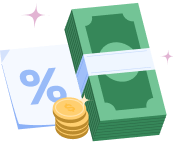Table of Contents
Credit card overspending may seem harmless in the moment, but it quietly erodes financial stability. Understanding its impact is crucial, as mounting debt, high interest rates, and poor credit decisions can shape your long-term economic future. Swiping your card feels easy until the bill arrives. In the U.S., the average credit card balance exceeds $6,000, and interest rates are at historic highs.
While credit cards provide convenience and flexibility, many consumers overlook how habitual overspending can sabotage their long-term financial stability. Beyond the mounting balances, the hidden costs of debt accumulation can ripple through every aspect of your future, from your credit score to your mental well-being.
Understanding Credit Card Overspending
Overspending happens when purchases exceed your ability to pay them off, often fueled by instant gratification and easy credit. Recognizing the psychological triggers and minimum payment traps is the first step toward breaking harmful spending habits. The “buy now, worry later” mindset is reinforced by marketing tactics and reward programs that make spending feel guilt-free. However, the real trap lies in minimum payments. Paying only the minimum each month gives the illusion of control, but it actually extends repayment timelines and multiplies interest costs. Over time, you end up paying far more than the original amount borrowed.
The Short-Term Consequences of Overspending
Credit card overspending has immediate consequences, including growing debt, late fees, and emotional stress. Recognizing these short-term effects can help prevent the compounding financial and personal problems that often follow reckless spending behavior.
Skyrocketing Interest and Debt Traps
Carrying balances leads to compounding interest, turning manageable spending into long-term debt. Even small balances can grow significantly, highlighting the importance of understanding interest rates and avoiding the pitfalls of revolving credit.
One of the first red flags of overspending is compounding interest. When you carry a balance, interest is charged on both your initial purchases and any unpaid interest from previous months. It creates a debt snowball that is difficult to escape.
For example, a $1,000 balance at 25% APR could take years to clear if only minimum payments are made. What feels like manageable spending today can spiral into years of repayments and thousands of dollars in interest.
Missed Payments and Late Fees
Missing payments triggers fees, higher interest rates, and damaged credit. These seemingly small missteps can quickly escalate, making repayment more challenging and signaling risk to lenders and creditors.
When you stretch your finances too thin, even one missed payment can have lasting consequences. Late payments trigger penalties and damage your credit score almost immediately. Lenders often respond by increasing your APR, reducing your credit limit, or adding penalty fees.
These changes make repayment even more difficult, setting off a chain reaction that is hard to reverse. Consistently missing payments also signals financial instability to future lenders, which limits your access to favorable credit terms.
Emotional and Mental Stress
Debt-induced stress affects mental health and relationships. Constant financial pressure can lead to anxiety, shame, and avoidance behaviors, showing that overspending is not just an economic problem but an emotional burden, too.
Beyond numbers and statements, overspending takes an emotional toll. Many people experience anxiety, shame, or guilt about their debt. It is common to avoid checking balances or opening credit card statements altogether.
Over time, this financial stress can affect relationships, productivity, and even sleep quality. What begins as occasional overspending can evolve into a pattern of emotional strain that seeps into every part of daily life.
Long-Term Impact on Your Financial Future
Overspending not only affects the present but also limits opportunities in the future. High credit utilization, poor credit scores, and delayed milestones like homeownership or retirement can compromise long-term financial security.
Lower Credit Score and Limited Opportunities
High utilization rates and missed payments lower your credit score, limiting access to loans, rentals, and employment opportunities. Building credit responsibly ensures more financial freedom and flexibility in the future.
A high credit utilization rate, spending more than 30% of your credit limit, signals risk to lenders and can significantly lower your credit score. A low score affects more than just loan approvals; it can influence rental applications, utility deposits, and even employment opportunities.
Establishing healthy credit habits early is crucial to maintaining financial flexibility. Products such as the Beem Card offer a healthier credit-building alternative by reporting positive payment behavior without charging fees or interest.
Higher Cost of Borrowing in the Future
Poor credit increases interest rates on future loans, making even essential purchases more expensive. Understanding this long-term consequence underscores why controlling debt today saves thousands tomorrow.
Overspending today can make future borrowing far more expensive. Lenders use your credit history to determine your reliability as a borrower. A poor record, marked by high utilization, missed payments, or defaults, translates into higher interest rates on auto loans, mortgages, and personal loans.
Consider this example: two borrowers apply for a $20,000 car loan. One has excellent credit and secures a 5% interest rate, while the other with poor credit pays 15%. Over five years, that difference adds up to thousands of dollars in extra payments.
Delayed Financial Milestones
Overspending can postpone major life goals, from buying a home to starting a family. Without proper debt management, resources are diverted from savings, retirement, or emergency funds, delaying financial independence.
Debt does not just affect your credit; it impacts your timeline for achieving life goals. Overspending can delay major milestones such as buying a car, owning a home, or starting a family. Instead of directing income toward savings, investments, or retirement, much of it goes toward servicing debt.
Without adequate savings, unexpected expenses can push you further into borrowing, creating a cycle that is difficult to escape. Financial freedom requires prioritizing long-term stability over short-term satisfaction.
The Interest and Fees Scene in the U.S.
In recent years, credit card interest rates in the U.S. have reached record highs, averaging around 25%. At the same time, annual fees, balance transfer charges, and penalty fees have risen sharply. This environment makes credit card debt one of the most expensive forms of borrowing.
Compounding interest magnifies the problem. When interest is added to your existing balance each month, even small overspends grow exponentially. A single $100 purchase left unpaid can snowball into hundreds of dollars in additional costs over time.
The Real Problem People Pay With Interest and Fees
Most consumers underestimate how much of their monthly payment goes toward interest rather than reducing the principal balance. For instance, if you pay $100 a month on a $5,000 balance at 25% APR, nearly two-thirds of that payment might cover interest alone. This means your actual debt decreases very slowly despite consistent payments.
Understanding your credit card statement, particularly the sections detailing APR, interest charges, and payment allocation, is key to breaking this cycle. Improving financial literacy can prevent years of avoidable debt and unnecessary payments.
How to Recognize Overspending Warning Signs
Identifying early signs of overspending can prevent long-term debt. Growing balances, reliance on credit for essentials, hidden spending, or frequent balance transfers indicate that spending habits need closer attention and proactive correction.
Key warning signs include:
- Your balance continues to grow even when you make regular payments.
- You rely on credit cards for daily essentials like groceries or gas.
- You hide spending from yourself or loved ones to avoid guilt.
- You frequently transfer balances or open new cards to stay afloat.
These red flags suggest it is time to re-evaluate your spending patterns. Modern budgeting tools, such as Beem AI Wallet or BudgetGPT, can automatically categorize your expenses and highlight risky behaviors. By identifying problem areas early, you can take proactive steps to regain control of your finances.
Smart Ways to Fix Credit Card Overspending
Practical strategies like tracking expenses, budgeting, and using responsible credit alternatives help regain control. Implementing structured spending rules and leveraging technology can break the cycle of overspending and rebuild financial stability.
Track and Categorize Every Expense
The first step toward financial recovery is awareness. Tracking every expense helps you understand where your money truly goes. Budgeting tools and apps simplify this process by automatically sorting transactions into categories. Over time, you will see patterns in discretionary spending and identify areas to cut back.
Adopt the 50/30/20 Rule for Spending Control.
The 50/30/20 rule is a simple yet effective framework for managing your income. Allocating 50% to needs, 30% to wants, and 20% to savings or debt repayment helps ensure you meet financial goals. Automating transfers to high-yield accounts or using instant transfer systems offered by tools like Beem helps reduce the risk of overspending.
Switch to Cash or Debit for Everyday Purchases
If you struggle with impulse spending, switching to cash or debit cards can help. Paying with cash creates a tangible sense of cost, reinforcing financial discipline. You are more likely to think twice about nonessential purchases when you see your money leaving your wallet. Debit transactions, unlike credit, draw directly from your available funds, helping you stay within your budget.
Consider Credit-Builder Alternatives
If you want to rebuild your credit without falling into the debt trap, consider safer options like the Beem Card. This card reports responsible usage to credit bureaus but charges no interest or hidden fees. It helps you improve your credit score gradually while eliminating the risk of accumulating high-interest debt. It makes it a valuable tool for anyone seeking to repair their financial health responsibly.
Building a Healthier Relationship With Credit
Credit is a tool, not a trap. Mindful usage, full repayments, and maintaining low utilization rates transform credit into a financial advantage, allowing strategic borrowing and preventing destructive overspending patterns.
Credit itself is not the enemy; it is how we use it that matters. A balanced relationship with credit means using it strategically and responsibly. Focus on paying your balances in full each month and maintaining utilization below 30%. Use credit to earn rewards or build history, not to cover everyday expenses you cannot afford.
Mindful spending and regular repayment habits ensure that credit remains a financial asset, not a burden. Smart tools such as Beem’s AI Wallet, Instant Cash, BudgetGPT, and the Beem Card can automate safer spending behaviors and keep you accountable.
Conclusion — Your Future Deserves Better Than Debt
Debt shapes the future more than most realize. By taking proactive steps, monitoring spending, and using tools wisely, individuals can regain control, achieve financial goals, and build lasting stability free from high-interest burdens.
Overspending does not just affect today’s credit card balance; it shapes tomorrow’s financial opportunities. Every dollar spent on interest is a dollar taken away from your future goals, whether that is buying a home, starting a business, or securing your retirement.
By reviewing your statements, setting clear budgets, and taking small but consistent steps, you can regain control over your finances and your peace of mind. Tools such as Beem Card and AI Wallet empower you to rebuild credit safely and spend smarter, because your future deserves better than debt.
FAQs on Overspending on Credit Cards
How does credit card overspending affect my credit score?
High credit utilization and missed payments can lower your credit score, signaling risk to lenders and making future borrowing more expensive. Responsible repayment and low balances are key to improvement.
Can I recover from credit card debt?
Yes. Through budgeting, consolidation, and consistent repayments, recovery is possible. Tools like Beem’s AI Wallet can automate payments and monitor progress toward becoming debt-free.
Should I close my credit card to stop spending?
Not always. Closing older cards can reduce your average credit age, which may lower your score. Instead, consider lowering your credit limit or using the card for small, recurring payments.
How can I stop emotional or impulse spending?
Pause before purchases, set spending limits, and enable transaction alerts. Tracking expenses through automated tools can help reduce emotional triggers and promote mindful spending.
What’s the best credit card alternative to avoid debt?
Credit-builder cards such as the Beem Card help you build credit responsibly without interest or hidden fees, offering a safe and effective way to strengthen your financial profile.
















































